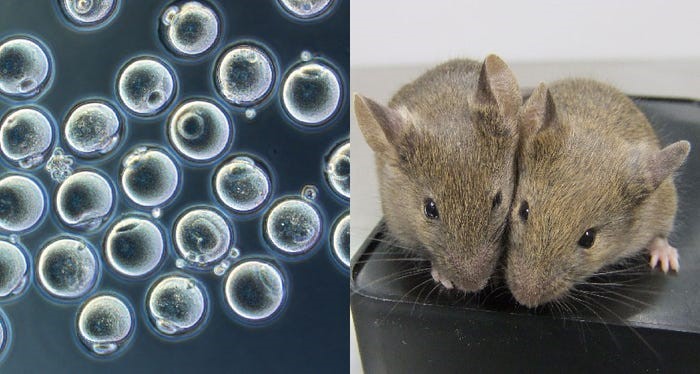MICE WITH TWO BIOLOGICAL FATHERS

Disclaimer: Copyright infringement not intended.
Context
- Japanese scientists have created mice with two biological fathers after they generated eggs from male cells for the first time.
- This is an advancement which has the potential to radically alter the course of reproductive biology.
Details of the study
- For the experiment, the scientists first took skin cells from the tail of a male mouse, which, just like male humans, contained both an X and Y chromosome, and then converted them into induced pluripotent stem cells or iPSCs — they can be transformed into any kind of cell.
|
READ: STEM CELLS: https://www.iasgyan.in/daily-current-affairs/stem-cells-11 Induced pluripotent stem cells Induced pluripotent stem cells (also known as iPS cells or iPSCs) are a type of pluripotent stem cell that can be generated directly from a somatic cell. |
- During this process, a slight percentage of the cells lost their Y chromosome, generating “XO” cells.
- The scientists then cultured the XO cells in the lab and treated them with a drug called reversine.
- This helped them duplicate the existing X chromosome in these cells, creating an XX set.
- The biggest trick here, is the duplication of the X chromosome.
- Scientists then embedded the XX cells in an artificial ovary — also created by the use of stem cells — to generate eggs, which were fertilized with the sperm of another male mouse to obtain hundreds of embryos that were implanted into the uterus of surrogate female mice.
Note: According to the scientists, the baby mice had a normal lifespan and they went on to have their own babies as adults. But only seven out of 630 implanted embryos produced living pups. Although they get quite a lot of eggs, these eggs are clearly not fully competent because they really get a very, very small proportion of them that are capable of being fertilised and forming embryos.
Can the technique be used in humans?
- Although it is theoretically possible to produce babies from male human couples, it would take around a decade to do so as there is less than one per cent success rate of the method used by the scientists to create mice with two biological fathers.
- Besides the technical aspect, the technique being used in the case of humans also poses a wide range of ethical questions.
Ethical questions raised;
What happens to all the embryos created but not used? Does it violate ethical norms of respect to create so many potential human lives knowing that the vast majority will be destroyed or indefinitely stored?”
Final Thoughts
- The breakthrough has opened new possibilities for gay-male couples — or even single men — to have their biological child without needing a female egg. However, scientists involved in the study pointed out that the research is in a very early stage.
Genome Concepts: https://www.iasgyan.in/blogs/genomic-and-genetic-concepts
|
PRACTICE QUESTION Q. Which of the following statements are correct with respect to Genetics? a. Epistasis is a circumstance where the expression of one gene is modified (e.g., masked, inhibited or suppressed) by the expression of one or more other genes. b. A founder effect, refers to the reduction in genomic variability that occurs when a small group of individuals becomes separated from a larger population. c. Induced pluripotent stem cells are a type of pluripotent stem cell that can be generated directly from a somatic cell. d. Eugenics is a discredited belief that selective breeding for certain inherited human traits can improve the “fitness” of future generations. 1) a and b 2) b and c 3) a, b and d 4) All of the above statements are correct. Correct Answer: Option 4 |



.jpeg)

1.png)
